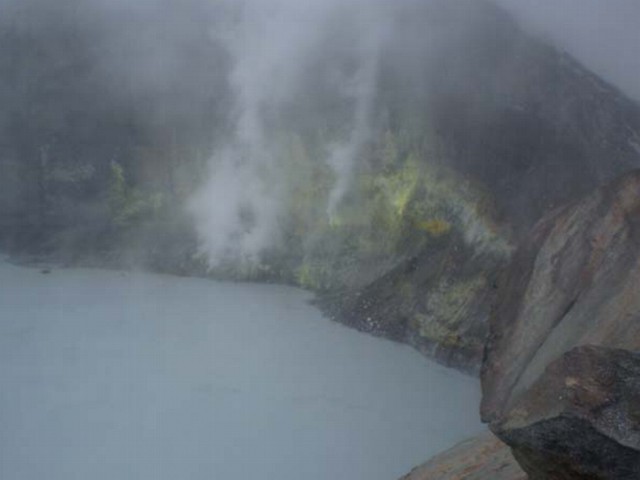Report on Rincon de la Vieja (Costa Rica) — April 2011
Bulletin of the Global Volcanism Network, vol. 36, no. 4 (April 2011)
Managing Editor: Richard Wunderman.
Edited by Jen Fela.
Rincon de la Vieja (Costa Rica) Fumarolically active but non-eruptive through January 2011
Please cite this report as:
Global Volcanism Program, 2011. Report on Rincon de la Vieja (Costa Rica) (Fela, J., and Wunderman, R., eds.). Bulletin of the Global Volcanism Network, 36:4. Smithsonian Institution. https://doi.org/10.5479/si.GVP.BGVN201104-345020
Rincon de la Vieja
Costa Rica
10.83°N, 85.324°W; summit elev. 1916 m
All times are local (unless otherwise noted)
Low-frequency earthquakes and tremor were reported at Rincón de la Vieja during the first half of 2008 (BGVN 33:07). Since then, Observatorio Vulcanologico Sismologica de Costa Rica-Universidad Nacional (OVSICORI-UNA) had issued intermittent reports of activity through January 2011. Those reports are summarized in the following sections, with much of the discussion centered around fumaroles and behavior of the geothermally warmed lake in the active crater. Occasional, typically small phreatic eruptions had occurred here in past years, for example in the 1990s (eg., BGVN 21:02, 21:03, 22:01, and 23:03) but were absent in the current reporting interval (last half of 2008 through January 2011).
August 2008. OVSICORI-UNA reported that the level of the lake was at a high level, with a bluish color, generated convection cells with evaporation, and had sulfur particles visible on it's surface. Sulfur deposition and fumarolic activity continued along the SW wall.
March 2009. In mid-March 2009, scientists visited the S and SW flank, collected samples, and noted some temperatures of 75-78°C. Because the visit occurred during the dry season, most areas encountered were dry. The scientists examined an area of acidification to the W of Von Seebach crater, ~3 km SW of the active crater. Strong winds common in that direction sometimes carried volcanic gases. Consequently, most of this narrow expanse only contained patches of grassland and shrubs that barely covered the rocky surface.
October 2009. OVSICORI-UNA reported that seismographic station RIN3, located ~5 km SW of the main crater, registered volcano-tectonic events and tremor lasting for minutes.
Weak ongoing fumarolic activity during 2010 through January 2011. OVSICORI-UNA reported that the level of the crater lake remained high during 2010, with constant evaporation. Geochemical, seismic, and deformation data did not show significant changes in physico-chemical parameters during 2010. The changing color of the lake, from blue to gray, was attributed to intense rains and fumarolic activity in the crater.
Later reporting. Reports during 2010 through at least January 2011 described fumarolic activity along the S and SW walls of the crater, with sulfur deposition and moderate gas discharge. The lake remained a gray color, with sulfur particles in suspension. Figure 15 shows a photo taken in April of the crater looking at the SW wall with fumarolic activity along with sulfur deposition. In April 2010, OVSICORI-UNA reported that the temperature of the lake was 49°C. A fumarole sometimes seen active along the N flank had stopped discharging gas.
OVSICORI-UNA reported that 2010 was unusual in that four domestic volcanoes were active: Arenal, Poás, Turrialba, and Rincón de la Vieja. Irazú was comparatively inactive (see separate report in this issue of the Bulletin).
Geological Summary. Rincón de la Vieja, the largest volcano in NW Costa Rica, is a remote volcanic complex in the Guanacaste Range. The volcano consists of an elongated, arcuate NW-SE-trending ridge constructed within the 15-km-wide early Pleistocene Guachipelín caldera, whose rim is exposed on the south side. Sometimes known as the "Colossus of Guanacaste," it has an estimated volume of 130 km3 and contains at least nine major eruptive centers. Activity has migrated to the SE, where the youngest-looking craters are located. The twin cone of Santa María volcano, the highest peak of the complex, is located at the eastern end of a smaller, 5-km-wide caldera and has a 500-m-wide crater. A Plinian eruption producing the 0.25 km3 Río Blanca tephra about 3,500 years ago was the last major magmatic eruption. All subsequent eruptions, including numerous historical eruptions possibly dating back to the 16th century, have been from the prominent active crater containing a 500-m-wide acid lake located ENE of Von Seebach crater.
Information Contacts: E. Fernández, W. Sáenz, E. Duarte, M. Martínez, S. Miranda, F. Robichaud, T. Marino, M. Villegas, and J. Barquero, Observatorio Vulcanologico Sismologica de Costa Rica-Universidad Nacional (OVSICORI-UNA), Apartado 86-3000, Heredia, Costa Rica (URL: http://www.ovsicori.una.ac.cr/).


